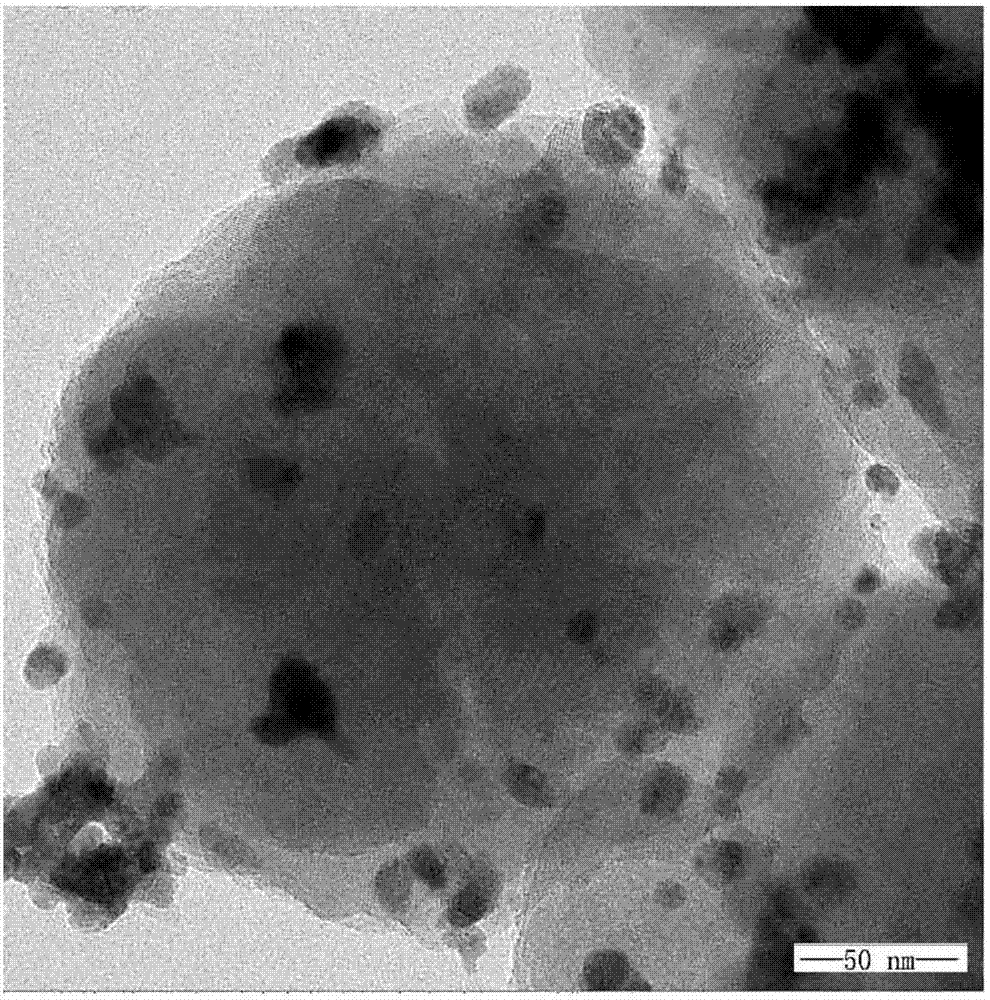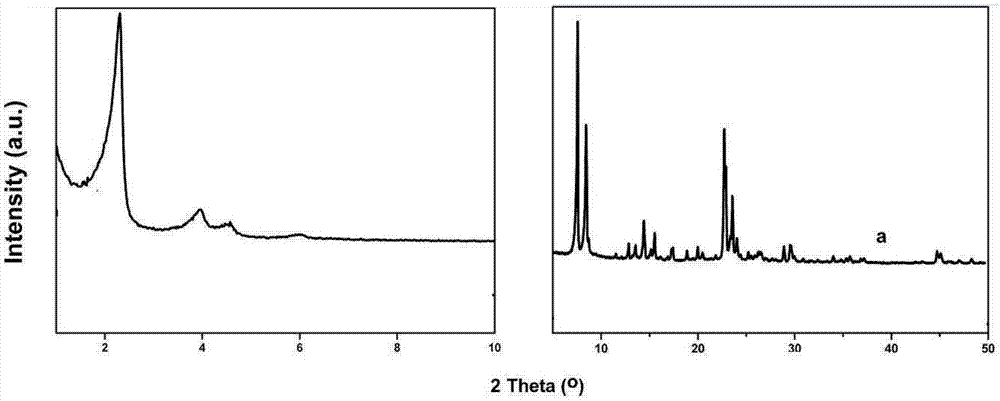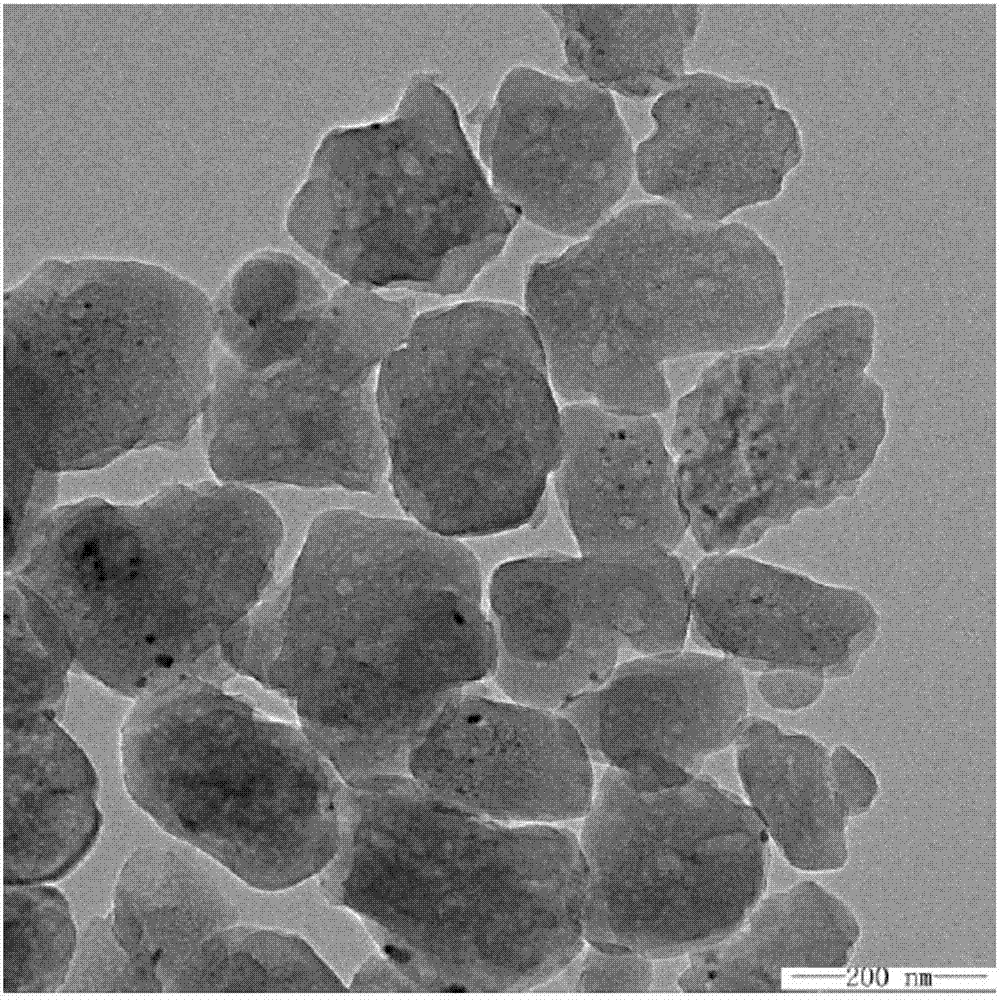Preparation method of catalyst with Fe nanoparticles inlaid into hierarchical pore molecular sieve crystal particles
A nanoparticle and molecular sieve technology, which is applied in the direction of molecular sieve catalysts, molecular sieve compounds, molecular sieves and base exchange compounds, etc., can solve the problems of easy aggregation and deactivation of loaded metal oxides, blockage of molecular sieve channels, etc., and achieve high selectivity, high pore volume, high The effect of specific surface area
- Summary
- Abstract
- Description
- Claims
- Application Information
AI Technical Summary
Problems solved by technology
Method used
Image
Examples
Embodiment 1
[0027] Mix the complexing agent with the iron source solution and stir for 0.5h; add the template solution and stir for 2h; add the silicon source and stir for 12h; add the alkali source and continue stirring for 2h, the final molar ratio of the reactants is SiO 2 : 0.01 Fe: 0.02EDTA: 0.30TBAB: 111 H 2 O: 0.5NaOH The mixed gel was put into a synthesis kettle, and crystallized at 180° C. for 2 days under autogenous pressure; after the crystallization was completed, the solid product was separated by washing, and the product was washed with 95% ethanol solution, Then transfer the product to a quartz glass tube and reduce it with hydrogen gas at 400°C. The reduction time is 4 hours. Add the obtained product to the alkali solution; add the mixed solution to the template solution and stir for 3 hours; add silicon source, Stir for 3h; add alkali source, stir for 1h; the final molar ratio of reactants is SiO 2 : 0.30 CTAB : 111 H 2 O: 0.2NaOH Put the mixed gel into a synthesis kett...
Embodiment 2
[0029] Mix the complexing agent with the iron source solution and stir for 0.5h; add the template solution and stir for 2h; add the silicon source and stir for 12h; add the alkali source and continue stirring for 2h, the final molar ratio of the reactants is SiO 2 : 0.02 Fe: 0.04EDTA: 0.30 TBAB: 111 H 2 O: 0.5 NaOH Put the mixed gel into a synthesis kettle, and crystallize at 160°C for 24 hours under autogenous pressure; after the crystallization is completed, wash and separate the solid product, wash the product with 100% ethanol, and then Transfer the product to a quartz glass tube and reduce it with hydrogen at 400°C. The reduction time is 4 hours. Add the obtained product to the alkali solution; add the mixed solution to the template solution and stir for 3 hours; add silicon source and stir 3h; add alkali source and stir for 1h; the final molar ratio of reactants is SiO 2 : 0.30 CTAB : 111 H 2O: 0.2 NaOH Put the mixed gel into a synthesis kettle, crystallize at 180° C. ...
Embodiment 3
[0031] Mix the complexing agent with the iron source solution and stir for 0.5h; add the template solution and stir for 2h; add the silicon source and stir for 12h; add the alkali source and continue stirring for 2h, the final molar ratio of the reactants is SiO 2 : 0.01 Fe: 0.02EDTA: 0.30TMAOH: 111 H 2 O: 0.5 NaOH Put the mixed gel into a synthesis kettle, and crystallize at 200°C for 36 hours under autogenous pressure; after the crystallization is completed, wash and separate the solid product, and wash the product with 98% ethanol solution, Then transfer the product to a quartz glass tube and reduce it with hydrogen gas at 400°C. The reduction time is 4 hours. Add the obtained product to the alkali solution; add the mixed solution to the template solution and stir for 3 hours; add silicon source, Stir for 3h; add alkali source, stir for 1h; the final molar ratio of reactants is SiO 2 : 0.30 CTAB : 111 H 2 O: 0.2 NaOH Put the mixed gel into a synthesis kettle, crystallize ...
PUM
 Login to view more
Login to view more Abstract
Description
Claims
Application Information
 Login to view more
Login to view more - R&D Engineer
- R&D Manager
- IP Professional
- Industry Leading Data Capabilities
- Powerful AI technology
- Patent DNA Extraction
Browse by: Latest US Patents, China's latest patents, Technical Efficacy Thesaurus, Application Domain, Technology Topic.
© 2024 PatSnap. All rights reserved.Legal|Privacy policy|Modern Slavery Act Transparency Statement|Sitemap



